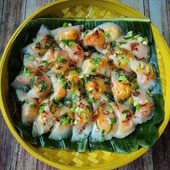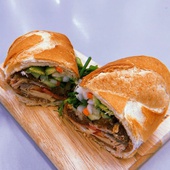3 Most Popular Tea Varieties in Vietnam
Don't forget to pick up some lotus tea and bring home as gifts
With the history of planting tea for over 2000 years, Vietnam is one of the largest and oldest tea-producing countries in the world. Although the history of Vietnamese tea has not been well recorded as that of the Chinese or Japanese, tea drinking occupies an essential role in Vietnamese culture, both in the past and in the present.
With a wide range of varieties, tea in Vietnam can be categorized mainly into three groups: green tea, “trà mạn” (plain black tea), and scented tea - “trà ướp hương”. Join us on a journey to the vibrant world of traditional Vietnamese tea in 2025!
Green Tea - Trà Xanh
Green tea remains a central focus when discussing Vietnamese tea. Since the mid-20th century, it has been extensively cultivated across Northern and Central Vietnam, gradually becoming symbolic of the everyday life and serene landscapes of the countryside.
 Green tea - photo: @homestaytonyluan
Green tea - photo: @homestaytonyluan
Green tea thrives in Vietnam's fertile soil and favorable climate, flourishing in both flatlands and highland regions, sometimes even grown in family gardens. Characterized by taller trunks and larger leaves than other tea varieties, green tea can be enjoyed fresh, requiring no wilting or oxidation. Simply steeping the freshly picked leaves in hot water will yield a flavorful brew within minutes.
As an agricultural country, Vietnam's rural inhabitants heavily rely on farming, making green tea an ideal beverage for cooling off during hot tropical summers. In addition to refreshing, green tea enhances the body’s resistance to infections.
It is no surprise that green tea is an integral part of daily life for Vietnamese farmers. Easy to prepare and enjoy, it’s consumed everywhere—whether taking a break in the shade during farming or relaxing on a patio after a long day. The image of people gathered at a small stall near the village gate, chatting amiably over green tea served in porcelain bowls, encapsulates the rural Vietnamese lifestyle.
Occasionally, Vietnamese also enjoy “nước vối” (made from a plant native to Northern Vietnam) as an alternative to green tea. The buds and leaves of the “voi” tree are dried in a straw-covered basket and then served similarly to green tea.
In recent years, recognizing Vietnam’s passion for green tea and its health benefits, innovative producers have transformed this local beverage into canned drinks, making it accessible to urban dwellers and international consumers.
Plain Black Tea - Trà Mạn
Gaining a deep understanding of Vietnam’s “Trà Mạn”—plain dried tea leaves without additives—takes time and effort: from how to produce “trà mạn” from fresh leaves to how to brew a high-quality cup of it.
 Tra Shan Tuyet - Photo: @snowshanteavn
Tra Shan Tuyet - Photo: @snowshanteavn
Unlike green tea, the type of tea used to create “Trà Mạn” is typically cultivated in bushes that grow nearly one meter tall in lowland areas or complex terrains, such as Thai Nguyen, Tuyen Quang, and Phu Tho, as well as in the highlands of Lam Dong, Gia Lai, and Kon Tum.
Freshly picked tea buds and leaves undergo a drying process, followed by wilting, before being roasted in a controlled manner until they curl and lose moisture, transforming from green to black. Though it may seem straightforward, this process is quite complex, requiring skill to ensure that the buds retain their shape while lasting fragrance is preserved.
“Trà Mạn” can also be produced from Shan tea, known as Tra Shan or Tra Tuyet. This special tea variety, found in the remote northern provinces of Vietnam, particularly Ha Giang, consists of ancient wild tea plants that can reach up to 15 meters in height and two meters in diameter. Traditionally, skilled pickers climb the tea trees to harvest the buds, and, in times past, even trained monkeys assisted in gathering the leaves. The young leaves, covered in a fine layer of white hair, are what give “Trà Shan Tuyet”—or Snowy Shan Tea—their name. Organically cultivated and naturally harvested, Shan tea commands a premium price for its outstanding qualities.
Less common than green tea, “Trà Mạn” is prepared with specific skills by tea artisans, using the right type of teapot—different ceramics can influence the flavor—and, crucially, with a tranquil mind.
Scented Tea - Trà ướp Hương
Like many tea-producing regions, Vietnam has developed a unique process for enhancing the aroma of “trà mạn” by blending it with flowers and herbs. While internationally renowned varieties like Earl Grey and Chai have achieved global recognition, Vietnamese scented teas are distinguished by their earthy and local plant infusions.
 Che Sen - Photo: @hanhngotra
Che Sen - Photo: @hanhngotra
The aromatic combination of floral scents intertwined with the slightly bitter taste of tea results in a distinctive flavor, texture, and color in Vietnamese scented teas, referred to as “Trà hương.” Each variety is paired with specific flowers: tea leaves with chrysanthemum, tea buds with Sỏi flowers, and perhaps most famously, “trà mạn” with jasmine and lotus.
Lotus-scented tea—“trà sen”—is particularly emblematic of Vietnamese tea culture. The preparation of “trà sen” is not just time-consuming but also intricate, reflecting the grace, respect, and philosophical beliefs inherent in Vietnamese traditions.
The “trà mạn” used for making “trà sen” is not fully dried after roasting. Instead, the tea buds and leaves are placed in earthen jars, covered with banana leaves, and stored for nearly two years to diminish bitterness and enhance the tea's ability to absorb fragrance. To produce one kilogram of “trà sen,” approximately 800 to 1,000 lotus flowers, picked at dawn, are required. The tea is infused five to six consecutive times, ensuring that the leaves thoroughly soak up the pure, clean scent of the lotus.
Hi sir I need to is there any gréen tea name of palando

Best Things To Do In Moc Chau
Moc Chau Town is among the top-rated tourist destinations in northern Vietnam brimming with ultramodern and natural sightseeing attractions.

Vietnamese Snacks Among Best In The World
Vietnamese cuisine has long been known as among the most abundant and delicious cuisines in the world.

The Most Expensive "Banh Mi" In Ho Chi Minh City That Is Worth A Try
Long queues of Saigoneses, tourists, and shippers in front of the "banh mi" Huynh Hoa shop have long become a familiar scene every afternoon.








